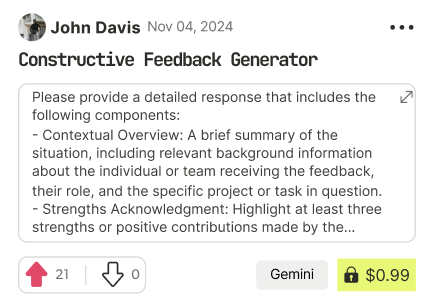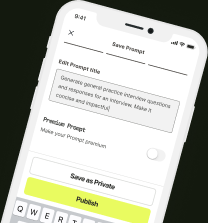prompt mine App
Find, Create & Share AI Magic
Neighborhood Clean-Up Drive Guide: A Step-by-Step Approach
This guide provides a comprehensive framework for organizing a successful neighborhood clean-up drive, emphasizing community engagement and environmental responsibility. Let’s work together to create a cleaner, healthier, and more vibrant community!
1. Pre-Event Planning: Laying the Foundation for Success
Define Objectives: Clearly articulate what you aim to achieve. Example: "Our goal is to remove litter from Elm Street Park and surrounding streets, increasing community pride and awareness of environmental issues." Set measurable goals (e.g., collect 50 bags of trash).
Form a Volunteer Team: Recruit dedicated individuals to lead different aspects of the clean-up (e.g., volunteer coordinator, supplies manager, publicity lead). Hold an initial meeting to assign roles and responsibilities. Dialogue: "Hey everyone, thanks for joining! Let's brainstorm how we can make this clean-up the best it can be!"
Secure Resources:
Funding: Apply for small grants from local organizations or businesses. Consider a fundraising bake sale or car wash.
Supplies: Solicit donations of trash bags, gloves, safety vests, and first-aid kits from local businesses. Contact your municipality for free trash pickup or disposal options.
Permits: Check if you need any permits from the city for using public spaces or blocking off streets.
2. Community Outreach and Engagement: Spreading the Word and Inspiring Action
Promote the Event:
Flyers and Posters: Design eye-catching flyers and posters to distribute throughout the neighborhood. Include date, time, location, and contact information.
Social Media: Create a Facebook event or use Nextdoor to reach a wider audience. Share photos of past clean-ups or environmental issues in the area.
Local Media: Contact local newspapers, radio stations, or TV stations to announce the event.
Word-of-Mouth: Encourage volunteers to personally invite their neighbors, friends, and family.
Encourage Participation: Offer incentives for participation, such as free t-shirts, refreshments, or a raffle drawing.
Build Community Ownership: Partner with local schools, community centers, or religious organizations to involve diverse groups. Example: Host a "design a clean-up poster" contest for kids. Dialogue: "We want everyone to feel like this is their clean-up – a chance to make a real difference together!"
3. Event Execution: Making it Happen Safely and Effectively
Logistics:
Registration: Set up a registration table on the day of the event to sign in volunteers and distribute supplies.
Designated Areas: Divide the clean-up area into smaller sections and assign teams to each section.
Equipment Distribution: Provide each team with the necessary supplies (trash bags, gloves, safety vests, etc.).
Safety Considerations:
Briefing: Conduct a safety briefing before the clean-up, emphasizing the importance of wearing gloves and safety vests.
Hazard Identification: Instruct volunteers to avoid sharp objects, hazardous materials, and dangerous areas. Provide clear instructions on reporting any hazards.
First Aid: Have a first-aid kit on hand and designate a volunteer to handle minor injuries.
Effective Waste Management:
Recycling: Provide separate bags for recyclable materials (plastics, glass, paper). Clearly label the bags.
Proper Disposal: Designate a central location for collecting filled trash bags. Coordinate with the municipality for pickup.
4. Post-Event Evaluation and Follow-Up: Celebrating Success and Planning for the Future
Assess the Impact:
Data Collection: Weigh the collected trash and recyclables to measure the impact of the clean-up.
Volunteer Feedback: Conduct a short survey or hold a debriefing meeting to gather feedback from volunteers on what worked well and what could be improved.
Recognize Volunteers:
Thank-You Notes: Send personalized thank-you notes to all volunteers, sponsors, and partners.
Awards Ceremony: Consider hosting a small awards ceremony to recognize outstanding contributions.
Social Media Shout-Outs: Publicly acknowledge volunteers and sponsors on social media.
Plan for Future Initiatives:
Regular Clean-Ups: Schedule regular clean-up events to maintain the cleanliness of the neighborhood.
Environmental Education: Organize workshops or presentations on environmental topics to raise awareness and promote sustainable practices.
Community Partnerships: Strengthen partnerships with local organizations to build a stronger network for future initiatives. Dialogue: "This is just the beginning! Let's keep this momentum going and make our neighborhood a shining example of community spirit and environmental stewardship!"

Find Powerful AI Prompts
Discover, create, and customize prompts with different models, from ChatGPT to Gemini in seconds

Simple Yet Powerful
Start with an idea and use expert prompts to bring your vision to life!
